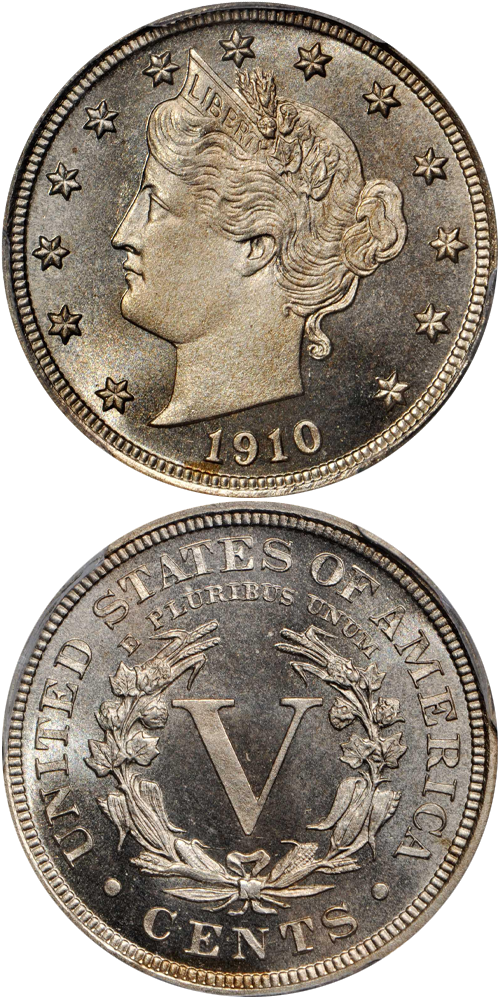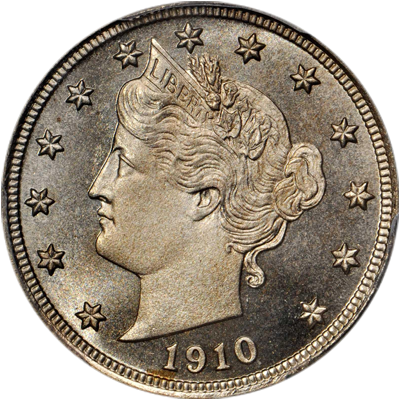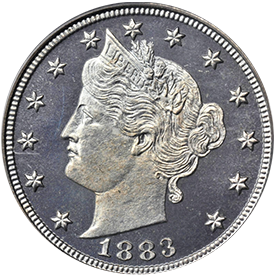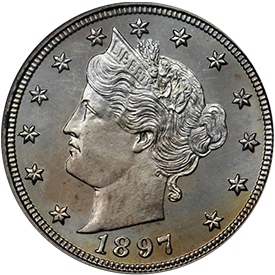The Liberty or “V” nickel, a design by Charles E. Barber (later responsible for the dime, quarter and half in 1892) appeared in 1883. The first design did not feature the word “CENTS” on the reverse – mint officials believing that the metal and size would be sufficient for the public to know it was a five-cent coin. Clever con artists gold plated the coins, with some even adding reeding on the edge, and attempted to pass them as $5 gold pieces. The mint, realizing their omission, quickly corrected the problem, and later in 1883, new coins appeared with the word “CENTS” below the large “V” on the reverse.
The ”V” nickel was a most useful coin throughout its roughly 30-year life, as the purchasing power of a nickel during that period was roughly equal to $1.00 (or even more) today. As a consequence, many were worn down to AG or Good condition due to their extremely active life in everyday circulation. Coins in Fine to EF condition are reasonably scarce to find today.
Drama surrounded both the first and “last” issue of the “V” nickel, for in 1913, five pieces were clandestinely struck by an “insider” at the Philadelphia mint, from dies prepared for 1913 in the event that the new design (featuring an Indian) was not yet authorized for use. These 1913 “V” nickels are among the most famous and valuable of all issues – even though they were “unofficial.”
Further Reading
Beginning in 1881, patterns were made for the so-called Liberty Head nickel design. The obverse featured a classic head of Miss Liberty, modeled after the goddess Diana it was said, a design which was considered at the time to be superior to the Shield motif. Liberty Head patterns were prepared of the one-cent, three-cent, and five-cent denominations. The value of each was stated in Roman numerals on the reverse, I, III, and V. No such standardization across these denominations was ever to take place, and the one-cent and three-cent pieces of this design were soon forgotten.
The Liberty Head motif lingered on for use with the nickel five-cent piece, and in 1882, many different patterns were produced. The obverse of most of these featured a head of Liberty surrounded by the legend UNITED STATES OF AMERICA. On the reverse the value was stated as V in combination with various wreaths and inscriptions. One piece, listed now as Judd-1690 in United States Patterns, is identical to the regular without-CENTS issue of the following year, 1883. This important transitional pattern has been a favorite with collectors. Around 1960 a specimen of this coin was displayed at one of the Central States Numismatic Society conventions. All by itself in solitary splendor the coin earned a prize! The 1882 Liberty nickel has great numismatic interest, just as the piece at the tail-end of the series, the 1913 Liberty nickel.
In 1883 the first regular Liberty nickels were made for circulation. The earliest design bore as a denomination the large letter V on the reverse. The word CENTS was not present. No one at the Mint gave any thought to a potential problem, for the pieces looked like nickels and were the size and shape of the then-familiar Shield types. However, the Mint did not reckon with the ingenuity of American citizens.
No sooner did the new Liberty nickels without CENTS appear than an interesting type of fraud was perpetrated with them. Certain individuals gold-plated the new nickels, and some with machining facilities even added reeded edges. As the diameter of the nickel is approximately the same as that of the United States $5 gold piece, a gold-plated Liberty nickel could be mistaken for a $5 gold piece of a new design. At this time the Liberty nickel design was not familiar to the public as a design for nickels, so anyone seeing such a gold-plated piece had no reason to attribute it to a lower value. The numeral V on the reverse, of course, could equally stand for $5 or 5c.
Gold-plated 1883 without-CENTS nickels were evidently made in large quantities, for specimens are often seen today with traces of gold plating made years ago. The story of these pieces, often called "racketeer nickels" today, has been recounted numerous times in numismatic literature. It has been related that one of the favorite ways to pass such pieces back in 1883 was not to offer one and say, "Here is a five-dollar gold piece, please give me change," but, rather, to purchase something such as a cigar or a piece of candy with a value of one or two cents.
The 1883 Liberty nickel plated to resemble a $5 gold piece would be tendered in payment. No words would be said. If the shopkeeper then gave $4.98 in change for a two-cent purchase, then the deception was complete. But, for legal purposes the person spending the nickel had not stated that it was a $5 gold piece and could claim complete innocence in the matter! On the other hand, should the shopkeeper return only three cents, realizing that it was a nickel, then the owner of the nickel could ask for that coin back and give him another one which had not been gold plated.
The Mint soon realized that it had made a mistake in the design. So, later in the year 1883 the word CENTS was added to the reverse. From 1883 through 1913 the design remained this style.
News of the Mint's oversight spread rapidly, and it was said that all of the error nickels without CENTS would be recalled. This precipitated a wild scramble, and vast quantities were squirreled away in bureau drawers, toy banks, and other locations. Feeding on this untrue rumor, sellers of coins and curiosities found a ready profit could be turned by selling such pieces to speculators and investors. As late as October 1886, long after the hoarding fervor had passed, John M. Hubbard, an early coin and stamp dealer, ran the following notice:
"The government has been calling in the V nickels of 1883 without CENTS ever since their coinage was stopped. They are melted and coined into the common nickels. We have a few of the variety without CENTS which we are selling at 15c each. Everyone who does not own a specimen should procure one at once as in a short time they will cost much more."
Eventually 1883 without-CENTS nickels purchased at three times face value in 1886 proved to be good investments, but not until more than a half century later. As recently as the 1940s, specimens traded hands in bulk quantities at just slightly over face value. With the advent of the popularity of type set collecting around 1960, the 1883 withoutCENTS nickel became the object of desire for thousands of new buyers, for such a coin was absolutely necessary to complete a grouping of nickels by designs. Year by year the price rose as the demand increased. Today large quantities are seldom seen, and Choice Uncirculated individual specimens are highly desired. It is also the most plentiful Liberty nickel in grades above Very Fine. Specimens are easily obtained and demand for them is widespread.
As numismatists were also caught up in the desire to own 1883 Liberty nickels without the CENTS feature, the Mint made 5,219 Proofs, one of the highest Proof mintage figures ever. Apparently, many of the nickels were sold in sets, for large numbers of 1883 Proof Shield nickels and Liberty nickels with CENTS were also produced.
Following the addition of CENTS later in 1883, nickels continued to be struck with this design officially through the year 1912. A number of scarce and rare issues exist within the series. 1885, with a business strike mintage of 1,476,490, is one of the most elusive, particularly in Uncirculated grade, for few were saved (collectors at the time preferred Proofs). 1886 is also scarce, as is 1894. While worn specimens of Liberty nickels exist in approximate proportion to the mintage figures, Uncirculated issues survived only as a matter of chance and are not available with the same consistency.
Abe Kosoff once told me that he spent several years looking for an Uncirculated 1891 Liberty nickel for a customer. His client insisted on an Uncirculated piece; a Proof wouldn't do. Finally, he located an example. Equipped with this knowledge I set about looking for 1891 Uncirculated nickels on my own, and while the issue seemed to be scarce, I was able to buy several over a period of years. This goes to show that what might be difficult for one person to locate might be acquired easily by another. Still, in terms of absolute supplies, an Uncirculated 1891 nickel is definitely rare, as are many other issues of the late nineteenth century. Most often seen today in Uncirculated grade are pieces from the late 1890s through 1912.
In the latter year nickels were struck at branch mints for the first time. The 1912-D nickel made its appearance as did the 1912-S, the latter with a restricted mintage of just 238,000. Immediately the 1912-S became scarce, and since the time of issue it has been considered to be a key date. Examples were struck from a bulged obverse die, with the result that the fields on a 1912-S nickel are slightly curved or bulged, quite unlike any other nickel in the series. This characteristic makes it easy to pinpoint when an S mintmark has been fraudulently added to a regular 1912 Philadelphia issue.
Diebreaks are often seen among early Liberty nickels, with issues of 1883 and 1884 being particularly plentiful in this regard. Uncirculated pieces of all dates are apt to show light striking on several obverse stars or at the lower part of the wreath on the reverse.
Proofs were made of all varieties from 1883 through 1912. Two interesting variations among Proofs may be of interest to nickel collectors. The first is a variety of the 1883 without-CENTS on which the “S” of PLURIBUS is sharply doubled. Normally a recut letter does not attract much attention, but in this instance, it is interesting to note that the same reverse die was used to make the transitional pattern 1882 Liberty nickel. The recut letter, which is sharply visible under magnification, serves as an identifying feature. Perhaps one out of three or four 1883 Proof nickels of this type has this recutting.
During the production of 1903 Liberty nickels at the Mint someone made a glaring mistake. During the striking of some pieces, the dies, rather than being oriented 180 degrees apart (so that the reverse appears upside-down), were aligned in the same direction. Of the total mintage of 1,790 Proof nickels of the year it is doubtful that more than a couple hundred had this slip. This issue, which has been overlooked by most cataloguers, first came to my attention around 1961 when my firm acquired the beautiful collection of coins formed by Ambrose Brown of Penn Yan, New York. His set of Proof Liberty nickels was mounted in a type of holder in which both sides of each coin are visible. Upon looking at the reverses I noticed that one was upside-down in relation to the others. I immediately thought that the coin had been placed in the holder upside-down, but upon examining the obverses of all the pieces I found that they were aligned properly. Ever since that time I have been on the lookout for 1903 Proof Liberty nickels with inverted reverses, and I have seen perhaps a dozen examples.
The rarity of Proof Liberty nickels is not particularly related to the rarity of Uncirculated Liberty nickels. As an example, 1,475 Proofs were made in 1907 as compared to more than 39 million business strikes. The Proof mintage ranks the 1907 as the rarest Proof in the series, while the generous business strike mintage reflects the situation that specimens in grades up to and including Uncirculated are among the most plentiful of the later dates. On the other hand, 1885, a prime scarcity in Uncirculated condition, is not particularly elusive in Proof, for 3,790 were struck in the latter format.
The 1913 Liberty Nickel
The last coin in the Liberty nickel series, the 1913, is a story in itself. In 1972 the Numismatic Scrapbook Magazine ran a fascinating feature article written by Courtney Coffing. The text delved into every aspect of this famous issue: how it was made, how it was publicized, the history of specimens trading over the years, and the collections possessing them. The story is one of the most absorbing I have ever read.
Not an official mint issue, the 1913 Liberty Head nickel was made privately at the Philadelphia Mint, presumably by one or more employees there (and also presumably without the knowledge of the officials of that institution). Samuel W. Brown, who supervised the security of the dies but who later moved to North Tonawanda, New York, to serve as mayor (and who later achieved minor publicity as a coin collector), has been pinpointed as the likely originator. At the time of issue, the existence of the 1913 Liberty nickel was known only to the person or persons who made them. It was not until 1919 that Brown ran advertisements in The Numismatist seeking to buy such pieces, as if he knew they existed.
Then, magically, at the 1920 ANA convention he appeared with a display of five of them! The implication, of course, was that he had bought them through his advertisements, but in later years when it was disclosed that he worked at the Mint in the coining department in 1913, a situation generally unknown to collectors in 1920, his source became suspect. Since no others have come to light since 1920, it is presumed that just five were struck, but the true story probably never will be known.
The 1913 Liberty nickel achieved fantastic fame during the 1920s and 1930s when B. Max Mehl used it as a focal point of his advertising to sell copies of his Star Rare Coin Encyclopedia, a compact volume which discussed all types of coins and listed the prices he would pay for them. He spent hundreds of thousands of dollars yearly advertising in magazines, newspapers, Sunday supplements, and even on the radio. Millions of citizens looked at their change hoping to find a rare 1913 Liberty nickel. None did. Thus, the coin became a household word with the American public.
Whenever a 1913 Liberty nickel changes hands publicly it is a matter of great interest to collectors and dealers. The J.V. McDermott specimen of this coin, bought by Aubrey Bebee for $46,000 at the American Numismatic Association convention in 1967, made headlines as did the purchase by World Wide Coin Company of the Edwin Hydeman coin from dealer Abe Kosoff. The latter specimen was handled by my firm, and through another company, Superior Galleries, was sold into the Jerry Buss collection. Another example, for which my firm provided an appraisal, was donated by Hon. and Mrs. R. Henry Norweb to the Smithsonian Institution in 1982. More recent sales during the decade of the 2010s have ranged in the $3–$4.5-million-dollar range.
While owning a 1913 Liberty nickel is the stuff of which dreams are made, and few will ever have that opportunity, the assembling of a set of regular issue Liberty nickels from 1883 to 1912 is a realistic goal. The most elusive issues are 1885 and 1912-S, followed by 1886. For those who can afford it, a run of Proofs, plus Uncirculated examples of 1912-D and 1912-S, forms a nice set. Much more difficult to piece together, but less expensive, is a run of Uncirculated pieces from 1883 onward.
In my opinion the Liberty nickel is one of the most attractive coin designs used for circulation during the past century. To me the coin seems to have an interesting sense of "Americana" about it, somewhat as the Indian cent does. Perhaps it is because so many Liberty nickels were made and because they were widely used by the public. Perhaps it is because the 1913 Liberty nickel has drawn attention to the series as a whole. The hypothetical travels of a worn Liberty nickel form the basis for the chapter, "Nickeldom," in my book Adventures with Rare Coins.









